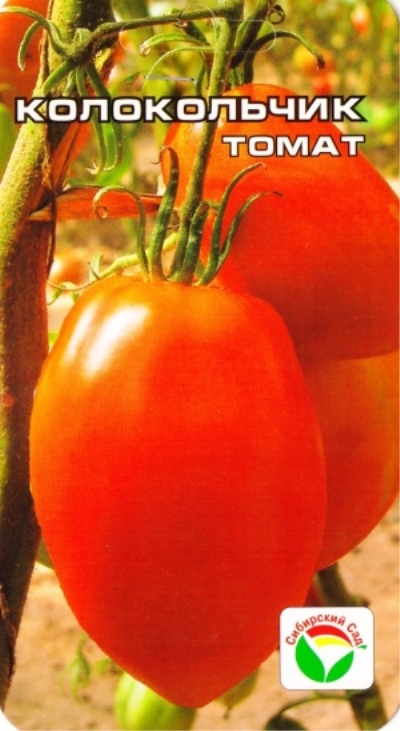
- Category: grade
- Growth type: indeterminate
- Appointment: universal
- Ripening period: mid-season
- Growing conditions: for film greenhouses, for greenhouses
- Bush size: tall
- Bush height, cm: up to 150
- Ripe fruit color: Red
- Fruit shape: elongated
- Fruit weight, g: 150-200 (up to 350)
Among summer residents and gardeners, tomato varieties are popular that are as unpretentious as possible in care, as well as those that can be grown in different regions, including those with rather cold climatic conditions. And there are such crops - for example, the Kolokolchik tomato variety, because it can be cultivated even in Siberia.
Description of the variety
The considered indeterminate variety differs in that its bushes grow up to one and a half meters. At a distance of 7 or 9 leaves from the ground, the first inflorescence will be laid, and then they appear every 3 leaves. Any of them, in turn, forms fruits - from 7 to 9 berries each. The variety can be described by several characteristics:
- red fruit color;
- harvesting is quite early, the first can be obtained after only 4 months;
- average fruit size;
- can be grown both in closed greenhouses and simply under a canopy;
- all-purpose vegetables - can be eaten fresh or used in a variety of culinary applications.
The main qualities of the fruit
The fruits of the Bellflower are red saturated in color, they are somewhat elongated in shape, at the bottom they have some sharpening. The size is average, from 150 to 200 grams, but there are also large specimens - 350 grams. Tomatoes of the variety are distinguished by their fleshiness, there are quite few seeds.
Taste characteristics
According to consumer reviews, Bellflower tomatoes taste excellent. They are eaten fresh, in salads, juice and sauce are prepared from them. But the main thing is that these tomatoes, due to the structure of the skin, are ideal for whole-fruit canning.
Ripening and fruiting
Bellflower is a tomato variety that can be classified in the mid-season category. And this means that 4 months after the sowing of the seeds is made, the harvest of fruits can be removed from the bush. The harvest season begins in July and continues in August.
Yield
According to the reviews of people growing the culture, the Kolokolchik variety can be called a high-yielding one. However, no specific figures have been provided.
The timing of planting seedlings and planting in the ground
Bellflower seedlings can be sown 50-60 days earlier before planting the bushes in a permanent area. At the same time, the daytime air temperature should be within 24-25 ° С above zero.

Growing tomato seedlings is an extremely important process, because it largely depends on whether the gardener will be able to harvest at all. All aspects must be taken into account, from seedbed preparation to planting in the ground.
Landing scheme
In order to plant seedlings in the ground, a certain scheme is used - 3 bushes are placed on each square.

Growing and care
Cultivation of the Kolokolchik variety occurs mainly in 1 or 2 trunks. Despite the fact that the variety is unpretentious, the plants will still need to be cared for. As already mentioned, the bushes definitely need a garter on any support. The Bellflower bush is usually quite tall, and under a mass of ripe berries, it can either bend, or even fall or break.
The culture will constantly need watering, as well as periodic fertilizing with mineral fertilizers. Experts recommend feeding tomatoes 3 to 4 times during the growing season. You need to water it weekly, after which it is important to loosen the soil, while removing weeds.




A plant needs different micronutrients at each stage of growth. All fertilizers can be divided into two groups: mineral and organic. Folk remedies are often used: iodine, yeast, bird droppings, eggshells.
It is important to observe the rate and period of feeding. This also applies to folk remedies and organic fertilizers.


Review overview
In their reviews, experienced gardeners talk about the fact that the Kolokolchik tomato variety grows very well even in harsh climatic conditions. The culture quite steadfastly tolerates all temperature changes in the air, and it can also be characterized as high-yielding, yielding fruits with excellent taste. In addition, farmers growing this variety noted that the bell is highly transportable, the fruits can be transported over long distances with virtually no loss.

























































































